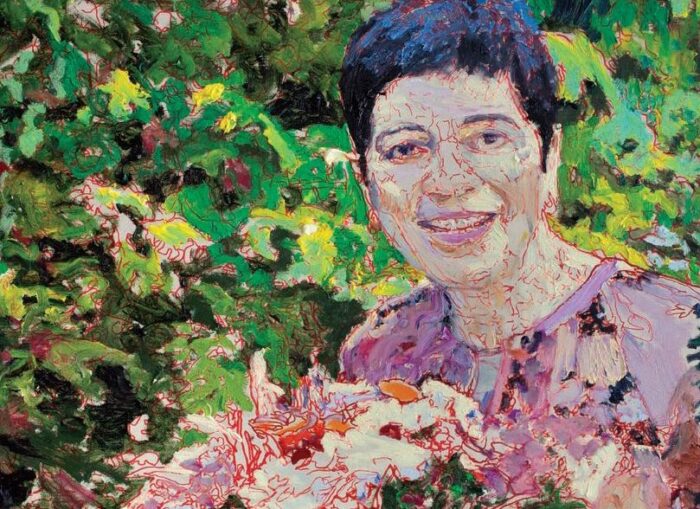
Possibly for similar reasons to Mr. Cieśniewski, I developed a sense of responsibility to decode my family’s past. I started asking, “why” and “how” did my family live, die, and survive?
Speech delivered at the opening of the Life, After All. Exhibition of paintings by Wojciech Cieśniewski, Otwock, August 18, 2022.
What struck me when I first saw Wojciech Cieśniewski’s work is the dialog we can see happening between him and the men, women, and children he paints.
“Who are you?” He asks. “What happened to you? Why did this happen?”. In the paintings of the Symchowicz family, I see him asking: “How exactly do you go on living after you’ve lost everyone you love?”.
He captures the dilemma of three of my grandparents––of surviving the unimaginable. The dilemma of many today who have survived, or who are enduring war: How do you start over after losing everything?
This dialog between past and present is precisely why I keep coming back to Otwock.
At first it wasto find the Przygoda Sanatorium on Warszawska, as my grandfather wanted me to, and to find the people who saved my mother.
Growing up in Australia, no one in my family talked about the war. I didn’t know that the Polish-speaking refugees I met in my grandparents living room drinking coffee had survived concentration camps. I didn’t understand why I could often hear my optimistic, cuddles-and-kisses mother sobbing in her bedroom. Or why my grandfather would sit in chair for days staring at the wall with far-away look in his eyes. I was a child then. Now I know that many Holocaust survivors and those who experience war often suffer from depression.
Two of my grandparents eventually told me some of their story. My grandmother said about Otwock: “There’s nothing left there. It’s all gone.”
But the first time I walked through the hallways of my family’s sanatorium, where one set of my grandparents met and fell in love, I could hear them call out to me. “Look, Karen! We came to Otwock with our families for holidays, to enjoy our friends, to dance, play cards, and read on the verandas. It was a paradise here!”
Possibly for similar reasons to Mr. Cieśniewski, I developed a sense of responsibility to decode my family’s past. I started asking, “why” and “how” did my family live, die, and survive?
I recently learned that my great grandmother, Dr. Helena Przygoda––who for a time ran her husband’s sanatorium on Warszawska––was rescued from the rubble of the Warsaw Ghetto Uprising by a Catholic woman who then hid her on the other side of the wall in her apartment. But then a szmalcownik approached this Righteous woman and demanded 5000 zł. to keep Dr. Przygoda secret.
I want to change the future, so I must ask the most difficult of questions: why were some willing to profit from and betray their fellow citizens while other risked their lives to save them?
I keep returning to Otwock because, like Mr. Cieśniewski and all those who made this exhibition possible, you are curious about the people who once lived in this town. You read Calel Perechodnik’s difficult memoir. You have shown the courage it takes to delve into a past where the lines between truth, conspiracy and propaganda, good and evil, friend or enemy, are not always clear.
Mr. Cieśniewski begs us to look deep into these paintings––beyond the canvas. He asks us to consider the shattered and fragmented identities.
But, I see hope in some of these paintings, too. I see resilience. I see strong men and women who will learn new languages and customs in new countries, who will study at universities, and raise families. Every day they had to push away thoughts of lost loved ones. Whenever they saw a child tossing a ball, a grandfather bouncing a granddaughter on his knee, their thoughts would hurl them back.
Helena Przygoda’s four sisters were all murdered, one in Wawer, days after she was caring for my mother. Helena did not know her son had survived Dachau. She threw her energy into managing the orphanage for Jewish children set up at Sródborowianka, her sister’s former hotel.
Support organizations and kind people helped some survivors to put one foot in front of the other, to move forward. As was the case with Thomas Buergenthal, explored here by Pan Cieśniewski. One of the youngest to survive Auschwitz, Mr Buergenthal dedicated his life to fighting for human rights, including 10 years on the International Court of Justice in The Hague..
My mother and her grandmother, Helena Przygoda, survived because some Polish people gifted them empathy and kindness. The same kindness many of you are showing to Ukrainian refugees. This exhibition and the memorial events of this week are important, to not forget whyyour fellow citizens were murdered. But I think it’s also important to remember why some survived.
Heartbreaking but yet a beautiful story of kindness and humanity. Thank you for sharing.